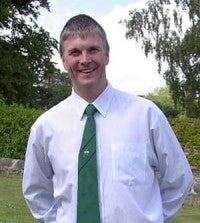Five Minutes of Fame Andy Newell
Pitchcare's Five Minutes of Fame
By Laurence Gale MSc
Pitchcare's five minutes of fame will be a new feature on the site offering the opportunity to promote individuals who have dedicated their life and careers to the sports ground industry. It is important that people are recognised and valued for their contributions to the industry. The profiles will include details of career, current role and their aspirations for the future. The aim is to feature and include as many people as possible, at all levels, who have played a part in promoting our diverse industry.
If you would like to feature someone or promote yourself in the five minutes of fame feature please send the relevant details to Laurence@pitchcare.com
This five minutes of fame features Dr Andy Newell, a well-respected turf grass scientist who works for The Sports Turf Research Institute (STRI) in Bingley.

Andy is currently Head of Turfgrass Biology at the STRI. He joined the Institute in 1988 and for the last 16 years has dedicated himself to testing grasses for different sports and amenity uses.
At the STRI Andy is responsible for all the biological research covering the living, dying and, some times, dead sports turf and amenity grasses. This also includes ecological research on golf courses, and notably in recent years a study of heather and other habitat management practices on golf courses in the UK and Ireland.
Andy also has a management role in the plant pathology and pesticide evaluation sections. The STRI run a Pesticide Safety Directorate approved pesticide evaluation laboratory. New European legislation will have a major impact on the availability of chemicals, with many of our older active ingredients being lost in the next couple of years. It is essential that the remaining chemicals and the limited numbers of new ones that come through the system are used efficiently and effectively.
An important area here is to ensure that we don?t encourage resistance in the pest, pathogen and weed populations. This is a critical issue now with some fungicides. Andy feels the industry needs to work together here and help to fund research into preserving the efficacy of chemicals we are left with. It is also important to look for alternatives to chemicals.
Andy is based mainly at the head office, but often gets involved in testing outside the Institute. He works with major sports governing bodies such as the R&A, The All England Lawn Tennis Club, and the England and Wales Cricket Board. For tennis, Andy has worked with Eddie Seward for the last ten years testing grasses for Wimbledon and monitoring how grasses perform on site.
Since starting at Bingley, Andy has been responsible for the STRI turfgrass evaluation programme and the annually published Turfgrass Seed booklet. In recent years, he has been involved with integrating this work into the BSPB (British Society of Plant Breeders) amenity grass programme, which is superceding the STRI work.
In terms of ?hot? topics, Andy has been involved in researching environmental conditions within some of the most prestigious stadiums and a number of new projects. In doing this, he has developed methodologies to conduct specialist studies at both the design and build stages of modern stadiums. Within this, Andy has developed techniques for mapping light levels within a stadium environment. His system can be used to determine the effects of structural developments on light levels reaching the playing surface. Andy says he can predict changes in light levels for any time of the day or year and in any part of the world. This type of information, coupled with experience gained from years of grass trials, gives Andy (he hopes) the ammunition to convince engineers of the importance of creating the right environment for grass growth in modern stadiums.
Andy's aims are to try and make turfgrass science accessible to those who would benefit from putting it into practice. He believes the industry best moves forward through good communication between the practical experts (groundsmen and greenkeepers) and scientists/advisors. However, this is very much a two-way process, all scientists need help to fully appreciate the practical implications of their work.
In terms of Turfgrass science, Andy is looking forward to next year's International Turfgrass Research Conference to be held in Wales, which will bring together all the leading turf scientists to talk and develop ideas on managing grasses for different sporting environments. (Link for details)
Outside work Andy is a keen sportsman and plays football, squash and golf. In fact, being a member of Bingley St Ives Golf Club some times gives Andy a dilemma - the golf course is nearer to his office than the STRI test plots. And, while on the subject of golf, Andy says he knows better than to blame the grass when having a bad game! As for the future - this industry will always throw out new challenges and together we shall strive to find the answers.
